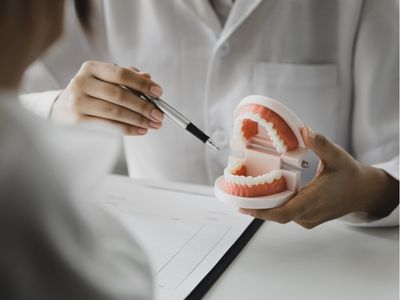What is Dry Socket (Alveolar Osteitis)?
It is quite common to encounter situations where the pain experienced after tooth extraction does not go away or even increases gradually. The pain, which is usually expected to ease within a day or two, becomes sharper and more disturbing, causing many people to worry. At this point, dry socket syndrome A condition called can occur. The loss of the clot that provides healing in the area where the tooth was extracted causes the bone to be exposed. This manifests itself with severe pain.
The main reason for this discomfort is that the clot that forms after the extraction cannot be preserved and the area cannot heal sufficiently. Although most people think of this as a simple toothache, the process requires more attention than you think. If left untreated, the risk of infection of the bone tissue increases and the healing process is delayed. Although dry socket treatment provides relief in a short time when done in a timely manner, it would be a much healthier way to prevent this condition from occurring in the first place.
İçindekiler
- What is Dry Socket (Alveolar Osteitis) and How Does It Occur?
- What are the Symptoms of Dry Socket After Tooth Extraction?
- What are the factors that increase the risk of dry socket?
- How to Treat Dry Socket? Medical and Natural Methods
- Dry Socket Healing Process and Things to Consider
- Methods to Prevent Dry Socket Formation After Tooth Extraction
What is Dry Socket (Alveolar Osteitis) and How Does It Occur?
The healing process after tooth extraction usually goes smoothly. However, in some cases, contrary to expectations, the protective clot in the cavity where the tooth was removed disappears and the delicate bone tissue is exposed. Alveolar osteitis is a very disturbing complication that occurs in this situation.
In a healthy healing process, the clot that forms in the extraction area supports both the closure of the wound and the development of new tissue. However, factors such as smoking, lack of oral hygiene, or rinsing the mouth too much after the extraction can cause this clot to break down. As the clot breaks down, the bone tissue close to the nerves is directly exposed to air and bacteria. The result is severe pain and discomfort.
Although this condition may be mild in some people, medical intervention is necessary in most cases. Dry socket treatment If the process is neglected, the risk of infection increases and the healing process is prolonged. Therefore, if any unexpected pain is felt after tooth extraction, a dentist should be consulted without delay.
What are the Symptoms of Dry Socket After Tooth Extraction?
Under normal conditions, it is natural to feel a slight ache after tooth extraction. However, this pain should decrease and disappear over time. If the pain does not decrease but rather intensifies, a different condition should be suspected. Dry socket symptoms usually appear within a few days after a tooth extraction.
- Sharp and throbbing pain in the extraction area
- Pain radiating to the jaw, ear or head area
- Feeling exposed bone tissue in the mouth
- An unpleasant, foul taste or odor
- A feeling of unbearable discomfort despite the absence of swelling
These symptoms should not be ignored when they start. Since dry socket is one of the most common complications after tooth extraction, early diagnosis and treatment will both accelerate healing and prevent the pain from getting worse.
What are the factors that increase the risk of dry socket?
Dry socket syndrome after every tooth extraction does not develop, but this risk is higher in some people. Conditions that prevent the clot from remaining stable may increase the likelihood of this complication.
- Smoking and using tobacco products
- Using birth control pills or blood thinners
- Not paying enough attention to oral hygiene
- Vigorous mouth rinsing or sucking on the extraction site
- Having a previous history of dry socket
Among the risk factors, smoking stands out as one of the most important reasons. Tobacco both delays healing by negatively affecting blood circulation and causes the clot to break down early. For this reason, it is strongly recommended not to smoke for at least a few days after tooth extraction.
 How to Treat Dry Socket? Medical and Natural Methods
How to Treat Dry Socket? Medical and Natural Methods
Dentists dry socket treatment It primarily aims to relieve pain and accelerate the healing process. The treatment process may vary depending on the severity of the condition.
- Clearing exposed bone and reducing irritation
- Disinfecting the area with antiseptic solutions
- Application of special anesthetic dressings that reduce pain
- Prescribing painkillers and antibiotics for home use
Among the methods that can be applied at home, there are also natural solutions such as gargling with salt water and cold compresses. However, such applications are only supportive and are not a substitute for medical treatment. Dry socket treatment is a process that requires professional intervention, and the best option is to proceed under the supervision of a dentist.
Dry Socket Healing Process and Things to Consider
Although the complete recovery from this condition varies from person to person, recovery is usually achieved within a week or two. However, there are some important points to consider during this process.
- Extra attention should be paid to oral hygiene.
- Smoking, alcohol and extremely hot and cold foods should be avoided.
- Hard foods should not be consumed
- Movements that will strain the extraction area should be avoided.
The most important point in the healing process is to prevent the clot from breaking down again. If the process is prolonged or the symptoms are getting worse, a dentist should definitely be consulted.
Methods to Prevent Dry Socket Formation After Tooth Extraction
It is much easier to prevent this condition than to treat it. Be careful after tooth extraction. It provides a healthy healing process without the need to ask how dry socket heals.
- After tooth extraction, the instructions given by the doctor must be followed completely.
- Smoking should be stopped for at least 72 hours.
- Actions such as rinsing the mouth or sucking the area should be avoided.
- Healing should be supported with a balanced diet.
When sensitive care is provided after tooth extraction, the healing process accelerates and possible complications are largely prevented. You can contact İnci Diş for more information about oral health and get support from specialist physicians.

 How to Treat Dry Socket? Medical and Natural Methods
How to Treat Dry Socket? Medical and Natural Methods 